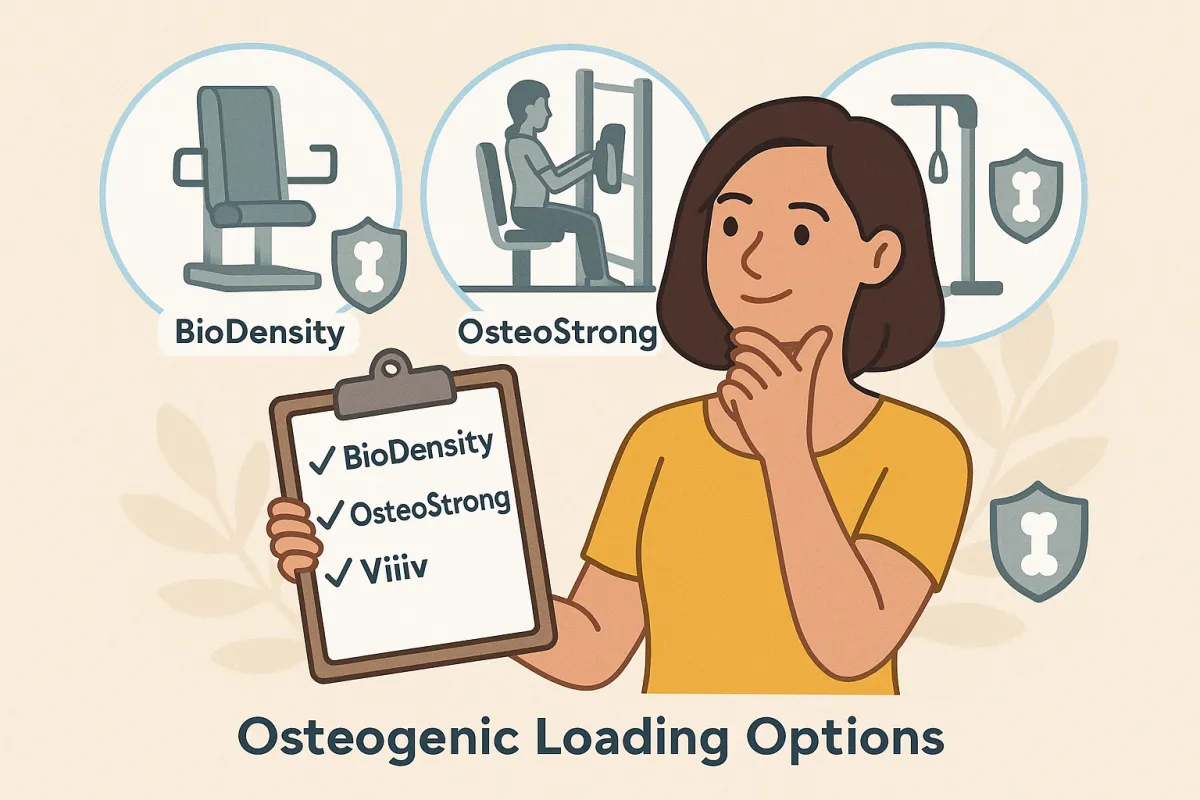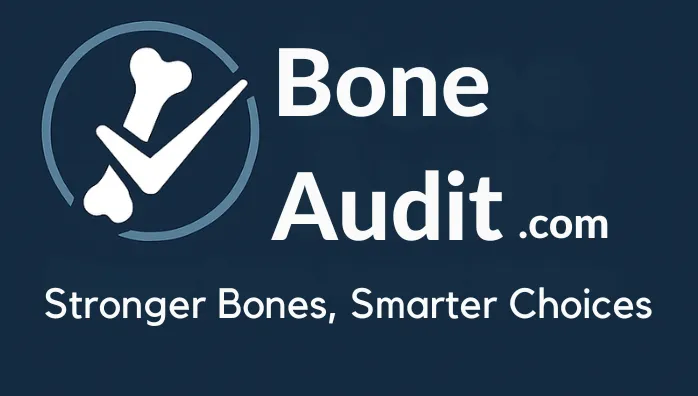
Osteogenic Loading: What It Is and How It Works
Not all exercise is created equal — especially when it comes to bone health.
While many forms of movement support general health, only a few generate enough force to trigger real improvements in bone density. One of the most promising approaches is osteogenic loading — a science-backed, joint-safe method that has gained traction globally.
This post breaks down what osteogenic loading is, where it came from, how it compares to other methods, and why OsteoStrong has become its most visible champion.
🧠 What Is Osteogenic Loading?
Osteogenic loading (OL) is a form of exercise designed to place very high force on the skeleton — enough to stimulate new bone growth without the risks of high-impact movement.
It’s grounded in Wolff’s Law, the principle that bones respond to the loads placed upon them by growing stronger when the right stimulus is applied.
This principle was first described by German anatomist Julius Wolff in the 1800s, who observed that bone adapts in response to mechanical stress.
In simple terms: your bones get stronger when you use them — and weaker when you don’t.
It’s the same reason astronauts lose bone mass in space, and why resistance training helps prevent age-related bone loss.
Wolff’s Law has stood the test of time — it remains a foundational concept in bone physiology and is still taught in medical schools today.
Osteogenic loading builds on this principle by applying controlled, high-intensity force that’s safe for joints and effective enough to stimulate meaningful bone adaptation — especially in areas most vulnerable to fracture.
The term “osteogenic loading” was coined by Dr. John Jaquish, who invented the first commercial OL device and remains a key figure in the field.
✅ Typical OL programs are short, supervised, and targeted:
Sessions are usually just 10–15 minutes once per week, and include pre- and post-exercises on vibration plates to improve circulation and neuromuscular response.
📜 A Quick Timeline
BioDensity® came first — a single, all-in-one machine designed to safely produce maximal isometric force. These machines are still used in clinics around the world today, with over 140 locations globally.
In 2011, Dr. John Jaquish co-founded OsteoStrong®, a global franchise that initially used BioDensity equipment but later developed its own suite of four separate machines to isolate different parts of the body.
As of today, OsteoStrong has over 200 centers worldwide and is the most well-known brand offering osteogenic loading to the public. It operates as a membership-based program, typically including weekly sessions supervised by coaches.
Newer players like Viiiv Fitness have entered the scene with more portable and affordable versions of OL machines.
💪 What Are the Benefits?
Research and real-world reports have associated osteogenic loading with:
Improved bone density and bone quality
Increased muscular strength and postural stability
Better balance and reduced fall risk
Reduced blood sugar levels
Decreased joint and back pain (anecdotally, from users)
🔬 What Does the Research Say?
There’s a growing body of research supporting OL, including:
Early studies on BioDensity-style equipment
Newer studies involving OsteoStrong protocols
Recent clinical research from Sweden and Greece, showing improvements in spinal bone density and maintenance of hip BMD — similar to the LIFTMOR study for REHITT²
🧪 Notably, these newer studies also showed positive changes in bone quality — a measure that is becoming more widely recognised as a stronger predictor of fracture risk than bone density alone.
These studies show promise — particularly for postmenopausal women and older adults — with the spine responding more consistently than the hip. Holding bone steady in the hip is still considered a positive outcome, especially in aging populations where bone loss is the norm.
🔍 A Closer Look at Osteogenic Loading (with More Focus on OsteoStrong)
This article places more focus on OsteoStrong simply because it is the most commercially successful provider of osteogenic loading worldwide.
Like any health-related intervention, OL has drawn both enthusiasm and criticism. In our view, some of these critiques are unfair or rooted in misunderstanding — especially from individuals who may not fully grasp the concept of osteogenic loading, or who may feel threatened by the idea that a different approach could reduce the relevance of their own methods or professional domain.
That said, fair critique is always welcome — so let’s walk through the most common ones.
⚠️ Criticism #1: Risk of Injury
Is osteogenic loading safe?
Any form of exercise carries some risk, and OL is no exception. Due to the high forces involved, it may not be suitable for people with severe frailty or acute joint pain.
However:
OL machines use joint-friendly positions
Sessions are closely supervised
Published studies to date report a very low rate of adverse events
In practice, OL may be safer than unsupervised weightlifting in older adults — especially when delivered through trained providers.
⚠️ Criticism #2: “But It’s a Franchise...”
The word “franchise” can evoke mixed reactions — especially when tied to something that feels semi-clinical.
But here’s the bottom line:
Clinics offering BioDensity also charge for sessions
Franchises like OsteoStrong operate much like owner-led studios
Equipment, staffing, and supervision all come with cost — regardless of the business model
If osteogenic loading sounds like a good fit, we recommend evaluating it based on the science — not the structure of the business.
⚠️ Criticism #3: Small Studies
Yes — most studies on osteogenic loading have relatively small sample sizes. But this is also true of other exercise studies like the LIFTMOR trial for REHITT, which included under 100 participants.
That’s not a flaw in OL — it’s a limitation of almost all physical intervention research.
Why? Because it’s time-consuming, expensive, and logistically complex to test exercise training across thousands of participants the way we do with medications.
Still, these smaller studies consistently show promising trends, particularly in the spine — and that’s valuable data, even if it’s not massive.
⚠️ Criticism #4: No Double-Blind or Placebo Group
Correct — it’s impossible to blind an exercise study the way you can with pills.
That doesn’t mean the results are invalid. In fact, newer OL studies have included control groups to improve comparison — even if they can’t fully blind participants.
This limitation is common to all movement-based research and should be taken into account — but not viewed as a red flag.
⚠️ Criticism #5: Some Studies Show No Improvement in the Hip
Yes — just like REHITT, some OL studies show:
Improved bone density in the spine
No average change in the hip
Here’s why this is significant:
✅ We expect bone density to decline with age — so even holding steady suggests the intervention is effective.
✅ When no average change is seen, that typically means 50% of participants gained BMD, while the other 50% lost some — and this is remarkable. Few interventions show measurable bone density gains in half of a postmenopausal population.
So why didn’t the other 50% improve?
Most likely, due to other unaddressed factors such as:
Poor protein intake
Low vitamin D3
Hormonal imbalances
Medications
These studies do not control for these other factors, because doing so would be logistically and financially unfeasible.
The most important takeaway: don’t stop at the conclusion.
Just because the average shows no gain in the hip doesn’t mean the intervention didn’t work — it means some people improved, and others likely had other issues blocking their progress.
This is where personalisation and ongoing assessment are key.
⚠️ Criticism #6: Some Studies Are Funded by OsteoStrong
This is true. But it’s also true of nearly every area of health research — from medications to supplements to devices.
As long as funding is disclosed and peer-reviewed, it doesn’t discredit the findings outright. It simply invites a critical reading of the methods and results — as it should.
⚠️ Criticism #7: “OsteoStrong Claims 15% BMD Gains in 6 Months”
This figure comes from a 2015 study conducted in the UK, which reported 15% improvement in both hip and spine BMD over six months using BioDensity equipment. Participants were also supplemented.
While the study was peer-reviewed and published, we believe:
It’s an outlier compared to more recent, higher-quality research
We don’t yet have enough detail to explain why the results were so high
It would be unrealistic to expect that most individuals will replicate these results
Our recommendation is to base decisions on the broader body of evidence — not on a single study.
Final Thought
If your goal is to improve bone density, not just maintain it, you’ll need to include some form of high-load, low-risk intervention.
That means either:
Osteogenic Loading (e.g., OsteoStrong, BioDensity, or Viiiv)
REHITT-style training (e.g., Onero or guided heavy lifting)
Both are backed by research and offer supervised, effective ways to stimulate your skeleton safely. The key is to find what fits your lifestyle — and stick with it.
The research supporting osteogenic loading so far is promising. While no study is perfect, the results are consistent enough to act on. Waiting for flawless trials may take a lifetime — and most of us don’t have that kind of time.
There will always be critics — many with vested interests or a preference for the status quo — who focus on what’s missing.
But don’t let that distract you from the bigger picture:
Wolff’s Law is real.
Bones respond to force — and the right kind, delivered safely and consistently, can change your bone health trajectory.
